Labour Relations Management in Singapore
VerifiedAdded on 2023/03/31
|11
|2355
|315
AI Summary
This article explores the players and dynamics of labour relations management in Singapore. It discusses the role of trade unions, government, and other stakeholders in ensuring a cooperative relationship between employers and employees. It also highlights Singapore's competitive advantage and its impact on the economy.
Contribute Materials
Your contribution can guide someone’s learning journey. Share your
documents today.

Labour Relations Management 1
LABOUR RELATIONS MANAGEMENT
By Students Name
Course Code
Professor
City, State
Date
LABOUR RELATIONS MANAGEMENT
By Students Name
Course Code
Professor
City, State
Date
Secure Best Marks with AI Grader
Need help grading? Try our AI Grader for instant feedback on your assignments.
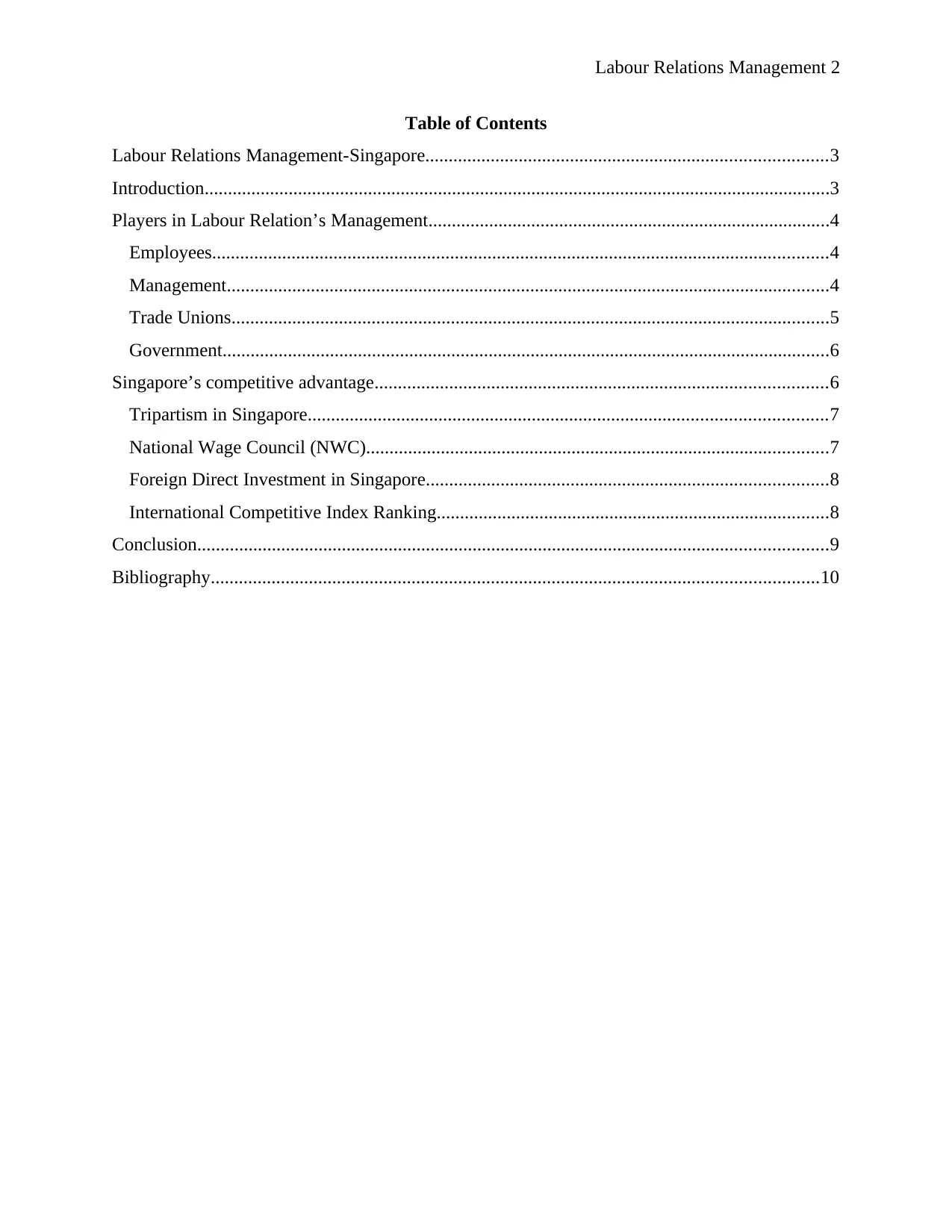
Labour Relations Management 2
Table of Contents
Labour Relations Management-Singapore......................................................................................3
Introduction......................................................................................................................................3
Players in Labour Relation’s Management......................................................................................4
Employees....................................................................................................................................4
Management.................................................................................................................................4
Trade Unions................................................................................................................................5
Government..................................................................................................................................6
Singapore’s competitive advantage.................................................................................................6
Tripartism in Singapore...............................................................................................................7
National Wage Council (NWC)...................................................................................................7
Foreign Direct Investment in Singapore......................................................................................8
International Competitive Index Ranking....................................................................................8
Conclusion.......................................................................................................................................9
Bibliography..................................................................................................................................10
Table of Contents
Labour Relations Management-Singapore......................................................................................3
Introduction......................................................................................................................................3
Players in Labour Relation’s Management......................................................................................4
Employees....................................................................................................................................4
Management.................................................................................................................................4
Trade Unions................................................................................................................................5
Government..................................................................................................................................6
Singapore’s competitive advantage.................................................................................................6
Tripartism in Singapore...............................................................................................................7
National Wage Council (NWC)...................................................................................................7
Foreign Direct Investment in Singapore......................................................................................8
International Competitive Index Ranking....................................................................................8
Conclusion.......................................................................................................................................9
Bibliography..................................................................................................................................10
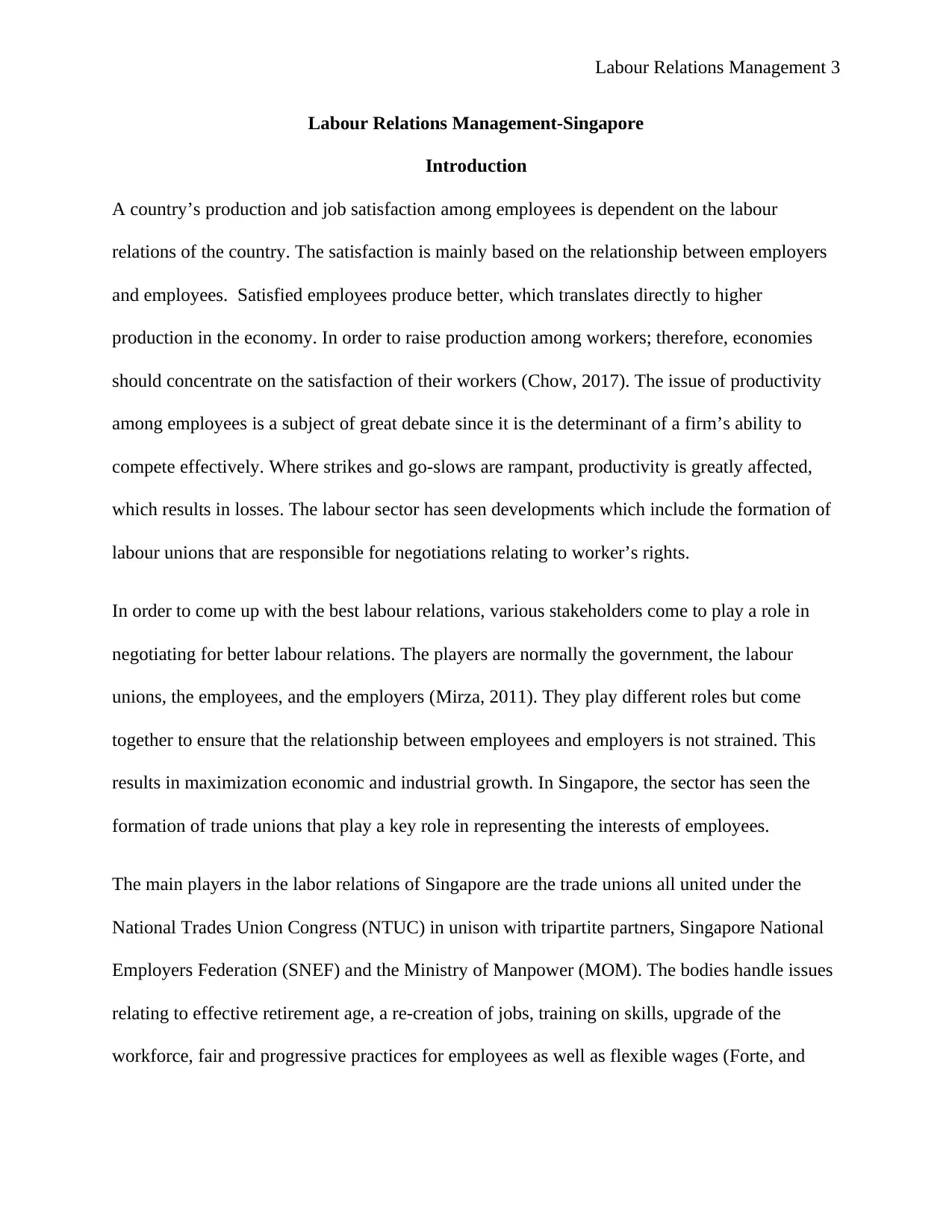
Labour Relations Management 3
Labour Relations Management-Singapore
Introduction
A country’s production and job satisfaction among employees is dependent on the labour
relations of the country. The satisfaction is mainly based on the relationship between employers
and employees. Satisfied employees produce better, which translates directly to higher
production in the economy. In order to raise production among workers; therefore, economies
should concentrate on the satisfaction of their workers (Chow, 2017). The issue of productivity
among employees is a subject of great debate since it is the determinant of a firm’s ability to
compete effectively. Where strikes and go-slows are rampant, productivity is greatly affected,
which results in losses. The labour sector has seen developments which include the formation of
labour unions that are responsible for negotiations relating to worker’s rights.
In order to come up with the best labour relations, various stakeholders come to play a role in
negotiating for better labour relations. The players are normally the government, the labour
unions, the employees, and the employers (Mirza, 2011). They play different roles but come
together to ensure that the relationship between employees and employers is not strained. This
results in maximization economic and industrial growth. In Singapore, the sector has seen the
formation of trade unions that play a key role in representing the interests of employees.
The main players in the labor relations of Singapore are the trade unions all united under the
National Trades Union Congress (NTUC) in unison with tripartite partners, Singapore National
Employers Federation (SNEF) and the Ministry of Manpower (MOM). The bodies handle issues
relating to effective retirement age, a re-creation of jobs, training on skills, upgrade of the
workforce, fair and progressive practices for employees as well as flexible wages (Forte, and
Labour Relations Management-Singapore
Introduction
A country’s production and job satisfaction among employees is dependent on the labour
relations of the country. The satisfaction is mainly based on the relationship between employers
and employees. Satisfied employees produce better, which translates directly to higher
production in the economy. In order to raise production among workers; therefore, economies
should concentrate on the satisfaction of their workers (Chow, 2017). The issue of productivity
among employees is a subject of great debate since it is the determinant of a firm’s ability to
compete effectively. Where strikes and go-slows are rampant, productivity is greatly affected,
which results in losses. The labour sector has seen developments which include the formation of
labour unions that are responsible for negotiations relating to worker’s rights.
In order to come up with the best labour relations, various stakeholders come to play a role in
negotiating for better labour relations. The players are normally the government, the labour
unions, the employees, and the employers (Mirza, 2011). They play different roles but come
together to ensure that the relationship between employees and employers is not strained. This
results in maximization economic and industrial growth. In Singapore, the sector has seen the
formation of trade unions that play a key role in representing the interests of employees.
The main players in the labor relations of Singapore are the trade unions all united under the
National Trades Union Congress (NTUC) in unison with tripartite partners, Singapore National
Employers Federation (SNEF) and the Ministry of Manpower (MOM). The bodies handle issues
relating to effective retirement age, a re-creation of jobs, training on skills, upgrade of the
workforce, fair and progressive practices for employees as well as flexible wages (Forte, and
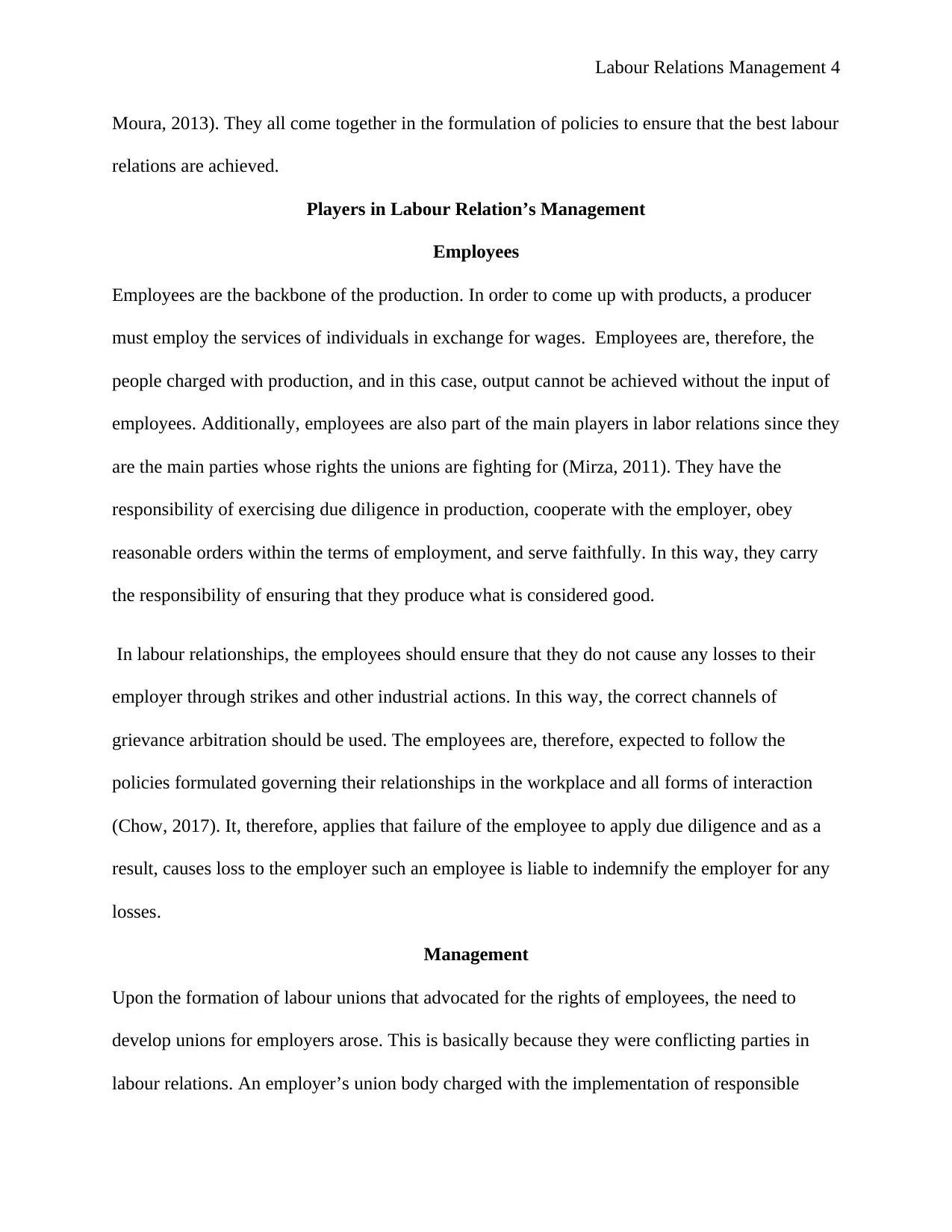
Labour Relations Management 4
Moura, 2013). They all come together in the formulation of policies to ensure that the best labour
relations are achieved.
Players in Labour Relation’s Management
Employees
Employees are the backbone of the production. In order to come up with products, a producer
must employ the services of individuals in exchange for wages. Employees are, therefore, the
people charged with production, and in this case, output cannot be achieved without the input of
employees. Additionally, employees are also part of the main players in labor relations since they
are the main parties whose rights the unions are fighting for (Mirza, 2011). They have the
responsibility of exercising due diligence in production, cooperate with the employer, obey
reasonable orders within the terms of employment, and serve faithfully. In this way, they carry
the responsibility of ensuring that they produce what is considered good.
In labour relationships, the employees should ensure that they do not cause any losses to their
employer through strikes and other industrial actions. In this way, the correct channels of
grievance arbitration should be used. The employees are, therefore, expected to follow the
policies formulated governing their relationships in the workplace and all forms of interaction
(Chow, 2017). It, therefore, applies that failure of the employee to apply due diligence and as a
result, causes loss to the employer such an employee is liable to indemnify the employer for any
losses.
Management
Upon the formation of labour unions that advocated for the rights of employees, the need to
develop unions for employers arose. This is basically because they were conflicting parties in
labour relations. An employer’s union body charged with the implementation of responsible
Moura, 2013). They all come together in the formulation of policies to ensure that the best labour
relations are achieved.
Players in Labour Relation’s Management
Employees
Employees are the backbone of the production. In order to come up with products, a producer
must employ the services of individuals in exchange for wages. Employees are, therefore, the
people charged with production, and in this case, output cannot be achieved without the input of
employees. Additionally, employees are also part of the main players in labor relations since they
are the main parties whose rights the unions are fighting for (Mirza, 2011). They have the
responsibility of exercising due diligence in production, cooperate with the employer, obey
reasonable orders within the terms of employment, and serve faithfully. In this way, they carry
the responsibility of ensuring that they produce what is considered good.
In labour relationships, the employees should ensure that they do not cause any losses to their
employer through strikes and other industrial actions. In this way, the correct channels of
grievance arbitration should be used. The employees are, therefore, expected to follow the
policies formulated governing their relationships in the workplace and all forms of interaction
(Chow, 2017). It, therefore, applies that failure of the employee to apply due diligence and as a
result, causes loss to the employer such an employee is liable to indemnify the employer for any
losses.
Management
Upon the formation of labour unions that advocated for the rights of employees, the need to
develop unions for employers arose. This is basically because they were conflicting parties in
labour relations. An employer’s union body charged with the implementation of responsible
Secure Best Marks with AI Grader
Need help grading? Try our AI Grader for instant feedback on your assignments.
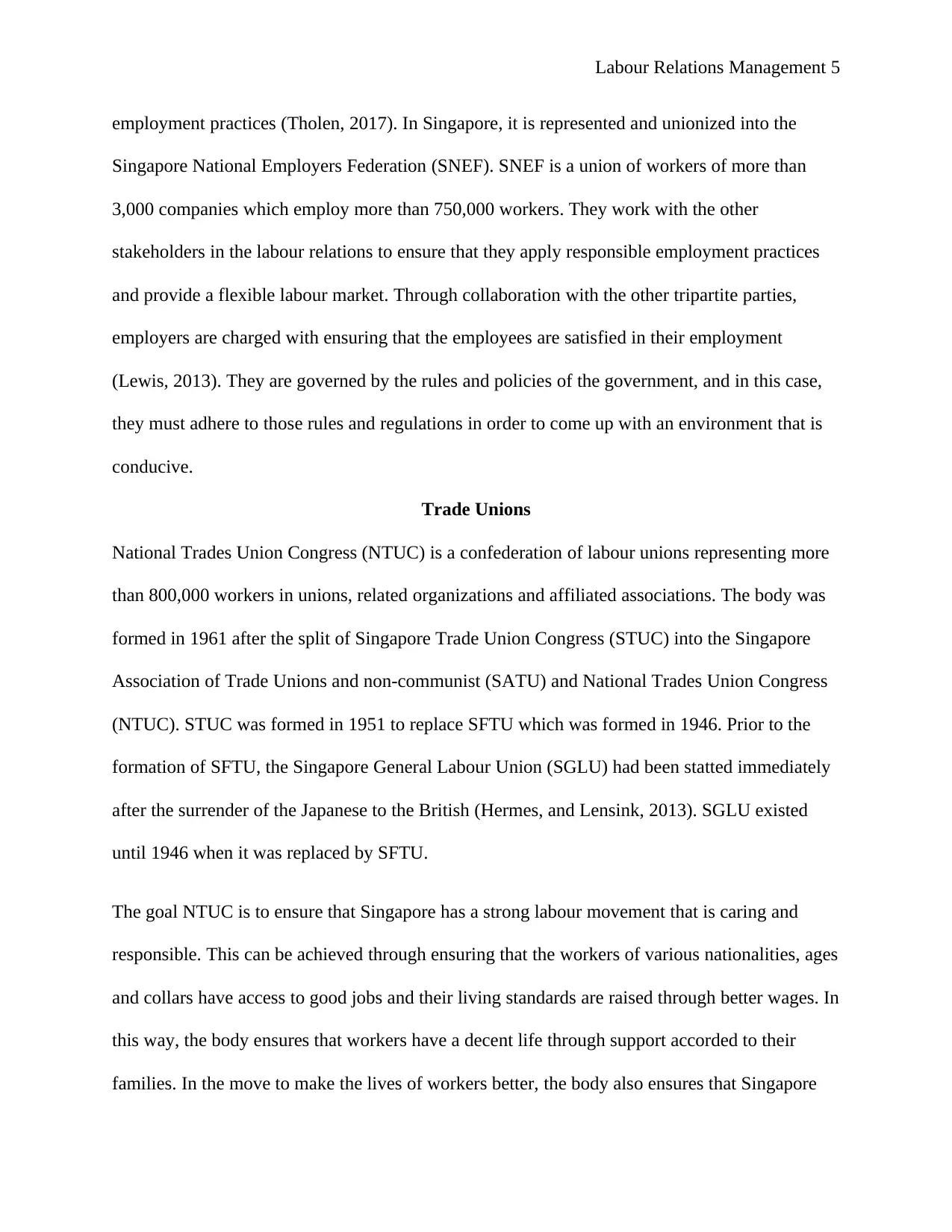
Labour Relations Management 5
employment practices (Tholen, 2017). In Singapore, it is represented and unionized into the
Singapore National Employers Federation (SNEF). SNEF is a union of workers of more than
3,000 companies which employ more than 750,000 workers. They work with the other
stakeholders in the labour relations to ensure that they apply responsible employment practices
and provide a flexible labour market. Through collaboration with the other tripartite parties,
employers are charged with ensuring that the employees are satisfied in their employment
(Lewis, 2013). They are governed by the rules and policies of the government, and in this case,
they must adhere to those rules and regulations in order to come up with an environment that is
conducive.
Trade Unions
National Trades Union Congress (NTUC) is a confederation of labour unions representing more
than 800,000 workers in unions, related organizations and affiliated associations. The body was
formed in 1961 after the split of Singapore Trade Union Congress (STUC) into the Singapore
Association of Trade Unions and non-communist (SATU) and National Trades Union Congress
(NTUC). STUC was formed in 1951 to replace SFTU which was formed in 1946. Prior to the
formation of SFTU, the Singapore General Labour Union (SGLU) had been statted immediately
after the surrender of the Japanese to the British (Hermes, and Lensink, 2013). SGLU existed
until 1946 when it was replaced by SFTU.
The goal NTUC is to ensure that Singapore has a strong labour movement that is caring and
responsible. This can be achieved through ensuring that the workers of various nationalities, ages
and collars have access to good jobs and their living standards are raised through better wages. In
this way, the body ensures that workers have a decent life through support accorded to their
families. In the move to make the lives of workers better, the body also ensures that Singapore
employment practices (Tholen, 2017). In Singapore, it is represented and unionized into the
Singapore National Employers Federation (SNEF). SNEF is a union of workers of more than
3,000 companies which employ more than 750,000 workers. They work with the other
stakeholders in the labour relations to ensure that they apply responsible employment practices
and provide a flexible labour market. Through collaboration with the other tripartite parties,
employers are charged with ensuring that the employees are satisfied in their employment
(Lewis, 2013). They are governed by the rules and policies of the government, and in this case,
they must adhere to those rules and regulations in order to come up with an environment that is
conducive.
Trade Unions
National Trades Union Congress (NTUC) is a confederation of labour unions representing more
than 800,000 workers in unions, related organizations and affiliated associations. The body was
formed in 1961 after the split of Singapore Trade Union Congress (STUC) into the Singapore
Association of Trade Unions and non-communist (SATU) and National Trades Union Congress
(NTUC). STUC was formed in 1951 to replace SFTU which was formed in 1946. Prior to the
formation of SFTU, the Singapore General Labour Union (SGLU) had been statted immediately
after the surrender of the Japanese to the British (Hermes, and Lensink, 2013). SGLU existed
until 1946 when it was replaced by SFTU.
The goal NTUC is to ensure that Singapore has a strong labour movement that is caring and
responsible. This can be achieved through ensuring that the workers of various nationalities, ages
and collars have access to good jobs and their living standards are raised through better wages. In
this way, the body ensures that workers have a decent life through support accorded to their
families. In the move to make the lives of workers better, the body also ensures that Singapore
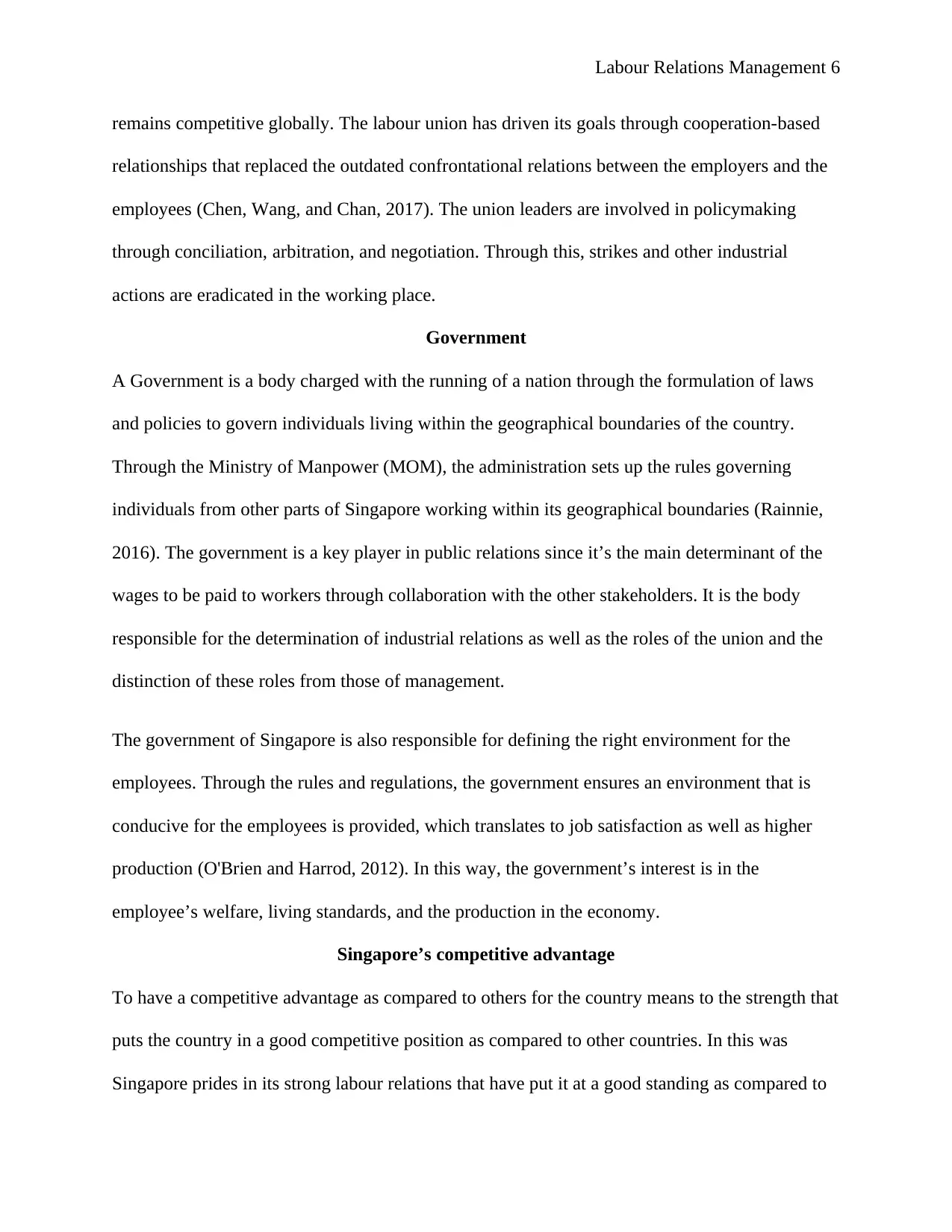
Labour Relations Management 6
remains competitive globally. The labour union has driven its goals through cooperation-based
relationships that replaced the outdated confrontational relations between the employers and the
employees (Chen, Wang, and Chan, 2017). The union leaders are involved in policymaking
through conciliation, arbitration, and negotiation. Through this, strikes and other industrial
actions are eradicated in the working place.
Government
A Government is a body charged with the running of a nation through the formulation of laws
and policies to govern individuals living within the geographical boundaries of the country.
Through the Ministry of Manpower (MOM), the administration sets up the rules governing
individuals from other parts of Singapore working within its geographical boundaries (Rainnie,
2016). The government is a key player in public relations since it’s the main determinant of the
wages to be paid to workers through collaboration with the other stakeholders. It is the body
responsible for the determination of industrial relations as well as the roles of the union and the
distinction of these roles from those of management.
The government of Singapore is also responsible for defining the right environment for the
employees. Through the rules and regulations, the government ensures an environment that is
conducive for the employees is provided, which translates to job satisfaction as well as higher
production (O'Brien and Harrod, 2012). In this way, the government’s interest is in the
employee’s welfare, living standards, and the production in the economy.
Singapore’s competitive advantage
To have a competitive advantage as compared to others for the country means to the strength that
puts the country in a good competitive position as compared to other countries. In this was
Singapore prides in its strong labour relations that have put it at a good standing as compared to
remains competitive globally. The labour union has driven its goals through cooperation-based
relationships that replaced the outdated confrontational relations between the employers and the
employees (Chen, Wang, and Chan, 2017). The union leaders are involved in policymaking
through conciliation, arbitration, and negotiation. Through this, strikes and other industrial
actions are eradicated in the working place.
Government
A Government is a body charged with the running of a nation through the formulation of laws
and policies to govern individuals living within the geographical boundaries of the country.
Through the Ministry of Manpower (MOM), the administration sets up the rules governing
individuals from other parts of Singapore working within its geographical boundaries (Rainnie,
2016). The government is a key player in public relations since it’s the main determinant of the
wages to be paid to workers through collaboration with the other stakeholders. It is the body
responsible for the determination of industrial relations as well as the roles of the union and the
distinction of these roles from those of management.
The government of Singapore is also responsible for defining the right environment for the
employees. Through the rules and regulations, the government ensures an environment that is
conducive for the employees is provided, which translates to job satisfaction as well as higher
production (O'Brien and Harrod, 2012). In this way, the government’s interest is in the
employee’s welfare, living standards, and the production in the economy.
Singapore’s competitive advantage
To have a competitive advantage as compared to others for the country means to the strength that
puts the country in a good competitive position as compared to other countries. In this was
Singapore prides in its strong labour relations that have put it at a good standing as compared to
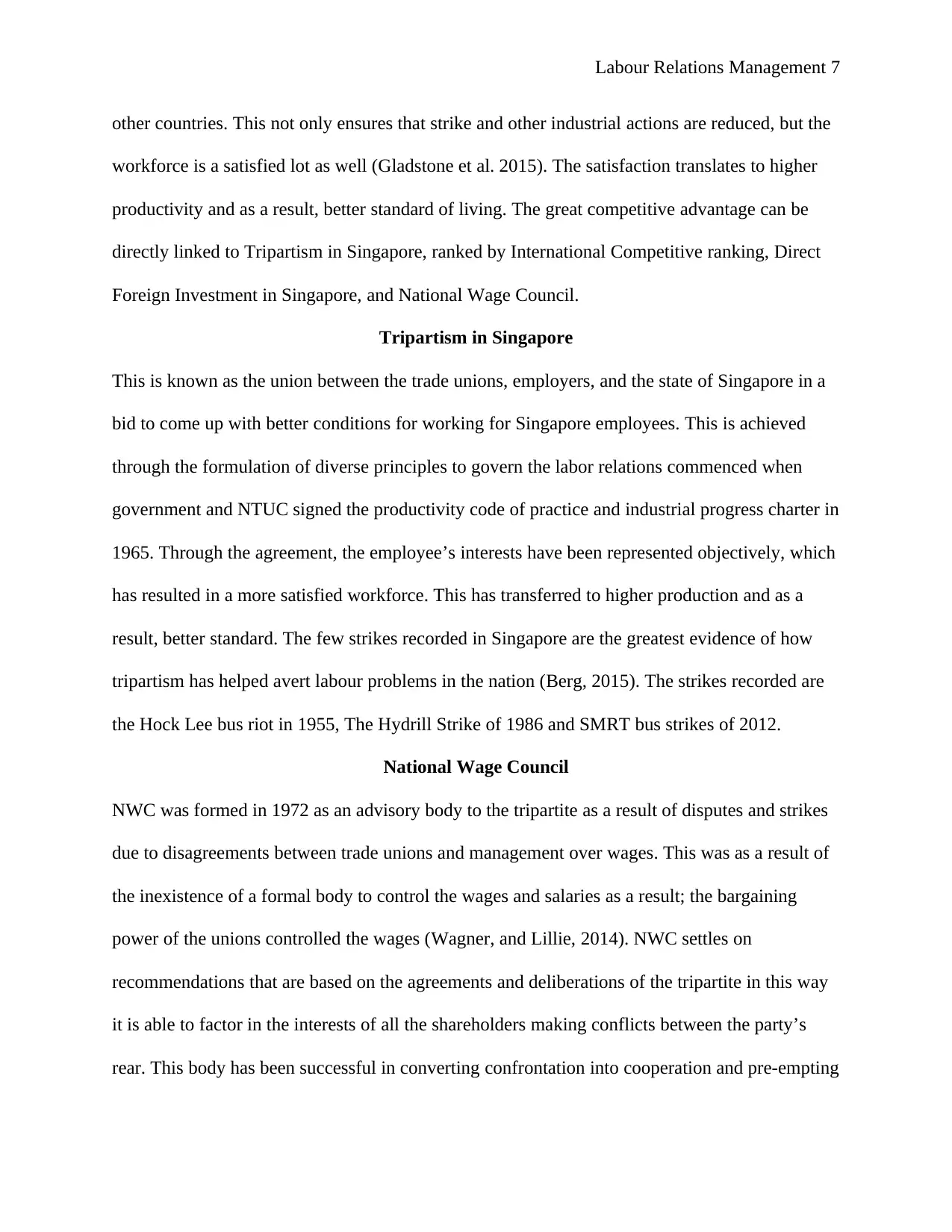
Labour Relations Management 7
other countries. This not only ensures that strike and other industrial actions are reduced, but the
workforce is a satisfied lot as well (Gladstone et al. 2015). The satisfaction translates to higher
productivity and as a result, better standard of living. The great competitive advantage can be
directly linked to Tripartism in Singapore, ranked by International Competitive ranking, Direct
Foreign Investment in Singapore, and National Wage Council.
Tripartism in Singapore
This is known as the union between the trade unions, employers, and the state of Singapore in a
bid to come up with better conditions for working for Singapore employees. This is achieved
through the formulation of diverse principles to govern the labor relations commenced when
government and NTUC signed the productivity code of practice and industrial progress charter in
1965. Through the agreement, the employee’s interests have been represented objectively, which
has resulted in a more satisfied workforce. This has transferred to higher production and as a
result, better standard. The few strikes recorded in Singapore are the greatest evidence of how
tripartism has helped avert labour problems in the nation (Berg, 2015). The strikes recorded are
the Hock Lee bus riot in 1955, The Hydrill Strike of 1986 and SMRT bus strikes of 2012.
National Wage Council
NWC was formed in 1972 as an advisory body to the tripartite as a result of disputes and strikes
due to disagreements between trade unions and management over wages. This was as a result of
the inexistence of a formal body to control the wages and salaries as a result; the bargaining
power of the unions controlled the wages (Wagner, and Lillie, 2014). NWC settles on
recommendations that are based on the agreements and deliberations of the tripartite in this way
it is able to factor in the interests of all the shareholders making conflicts between the party’s
rear. This body has been successful in converting confrontation into cooperation and pre-empting
other countries. This not only ensures that strike and other industrial actions are reduced, but the
workforce is a satisfied lot as well (Gladstone et al. 2015). The satisfaction translates to higher
productivity and as a result, better standard of living. The great competitive advantage can be
directly linked to Tripartism in Singapore, ranked by International Competitive ranking, Direct
Foreign Investment in Singapore, and National Wage Council.
Tripartism in Singapore
This is known as the union between the trade unions, employers, and the state of Singapore in a
bid to come up with better conditions for working for Singapore employees. This is achieved
through the formulation of diverse principles to govern the labor relations commenced when
government and NTUC signed the productivity code of practice and industrial progress charter in
1965. Through the agreement, the employee’s interests have been represented objectively, which
has resulted in a more satisfied workforce. This has transferred to higher production and as a
result, better standard. The few strikes recorded in Singapore are the greatest evidence of how
tripartism has helped avert labour problems in the nation (Berg, 2015). The strikes recorded are
the Hock Lee bus riot in 1955, The Hydrill Strike of 1986 and SMRT bus strikes of 2012.
National Wage Council
NWC was formed in 1972 as an advisory body to the tripartite as a result of disputes and strikes
due to disagreements between trade unions and management over wages. This was as a result of
the inexistence of a formal body to control the wages and salaries as a result; the bargaining
power of the unions controlled the wages (Wagner, and Lillie, 2014). NWC settles on
recommendations that are based on the agreements and deliberations of the tripartite in this way
it is able to factor in the interests of all the shareholders making conflicts between the party’s
rear. This body has been successful in converting confrontation into cooperation and pre-empting
Paraphrase This Document
Need a fresh take? Get an instant paraphrase of this document with our AI Paraphraser
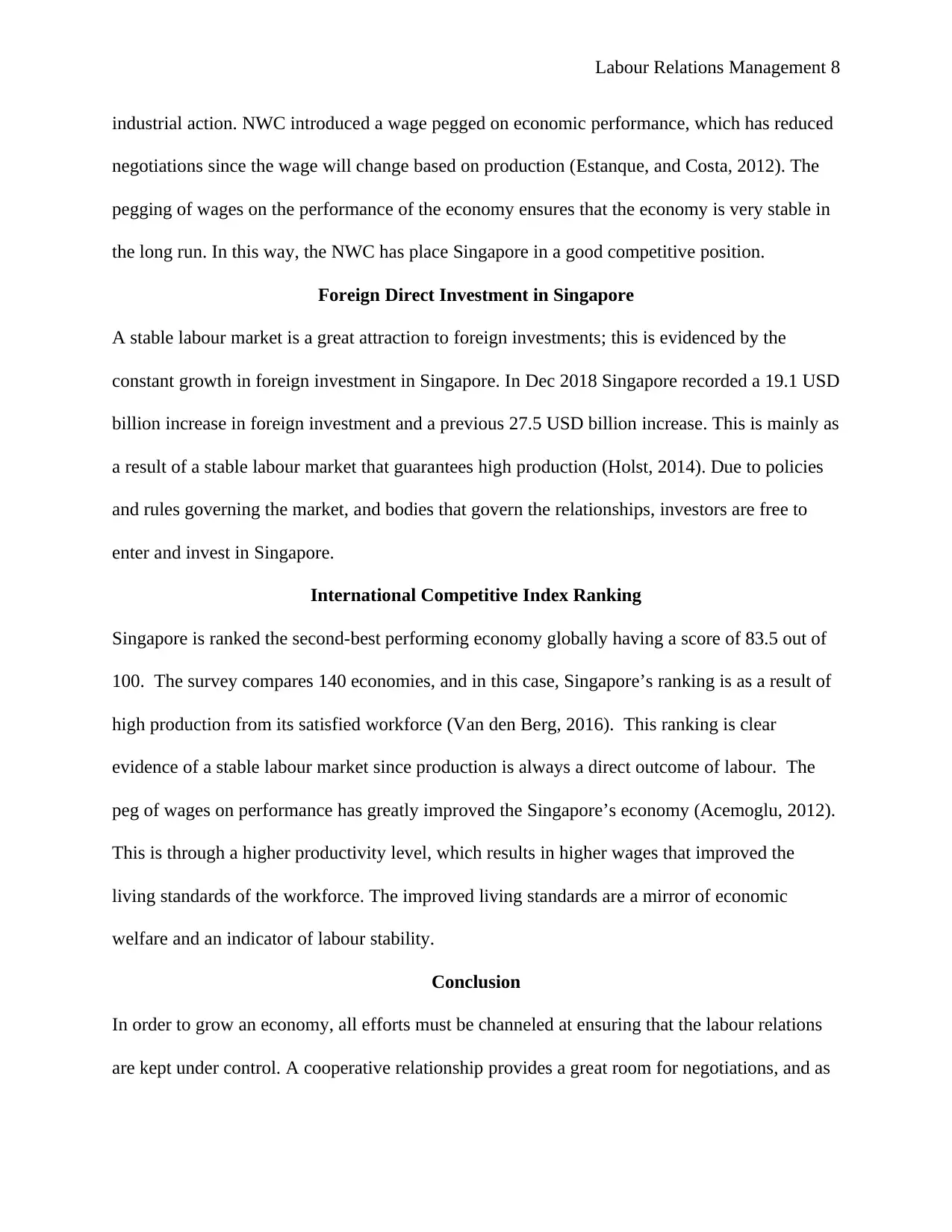
Labour Relations Management 8
industrial action. NWC introduced a wage pegged on economic performance, which has reduced
negotiations since the wage will change based on production (Estanque, and Costa, 2012). The
pegging of wages on the performance of the economy ensures that the economy is very stable in
the long run. In this way, the NWC has place Singapore in a good competitive position.
Foreign Direct Investment in Singapore
A stable labour market is a great attraction to foreign investments; this is evidenced by the
constant growth in foreign investment in Singapore. In Dec 2018 Singapore recorded a 19.1 USD
billion increase in foreign investment and a previous 27.5 USD billion increase. This is mainly as
a result of a stable labour market that guarantees high production (Holst, 2014). Due to policies
and rules governing the market, and bodies that govern the relationships, investors are free to
enter and invest in Singapore.
International Competitive Index Ranking
Singapore is ranked the second-best performing economy globally having a score of 83.5 out of
100. The survey compares 140 economies, and in this case, Singapore’s ranking is as a result of
high production from its satisfied workforce (Van den Berg, 2016). This ranking is clear
evidence of a stable labour market since production is always a direct outcome of labour. The
peg of wages on performance has greatly improved the Singapore’s economy (Acemoglu, 2012).
This is through a higher productivity level, which results in higher wages that improved the
living standards of the workforce. The improved living standards are a mirror of economic
welfare and an indicator of labour stability.
Conclusion
In order to grow an economy, all efforts must be channeled at ensuring that the labour relations
are kept under control. A cooperative relationship provides a great room for negotiations, and as
industrial action. NWC introduced a wage pegged on economic performance, which has reduced
negotiations since the wage will change based on production (Estanque, and Costa, 2012). The
pegging of wages on the performance of the economy ensures that the economy is very stable in
the long run. In this way, the NWC has place Singapore in a good competitive position.
Foreign Direct Investment in Singapore
A stable labour market is a great attraction to foreign investments; this is evidenced by the
constant growth in foreign investment in Singapore. In Dec 2018 Singapore recorded a 19.1 USD
billion increase in foreign investment and a previous 27.5 USD billion increase. This is mainly as
a result of a stable labour market that guarantees high production (Holst, 2014). Due to policies
and rules governing the market, and bodies that govern the relationships, investors are free to
enter and invest in Singapore.
International Competitive Index Ranking
Singapore is ranked the second-best performing economy globally having a score of 83.5 out of
100. The survey compares 140 economies, and in this case, Singapore’s ranking is as a result of
high production from its satisfied workforce (Van den Berg, 2016). This ranking is clear
evidence of a stable labour market since production is always a direct outcome of labour. The
peg of wages on performance has greatly improved the Singapore’s economy (Acemoglu, 2012).
This is through a higher productivity level, which results in higher wages that improved the
living standards of the workforce. The improved living standards are a mirror of economic
welfare and an indicator of labour stability.
Conclusion
In order to grow an economy, all efforts must be channeled at ensuring that the labour relations
are kept under control. A cooperative relationship provides a great room for negotiations, and as
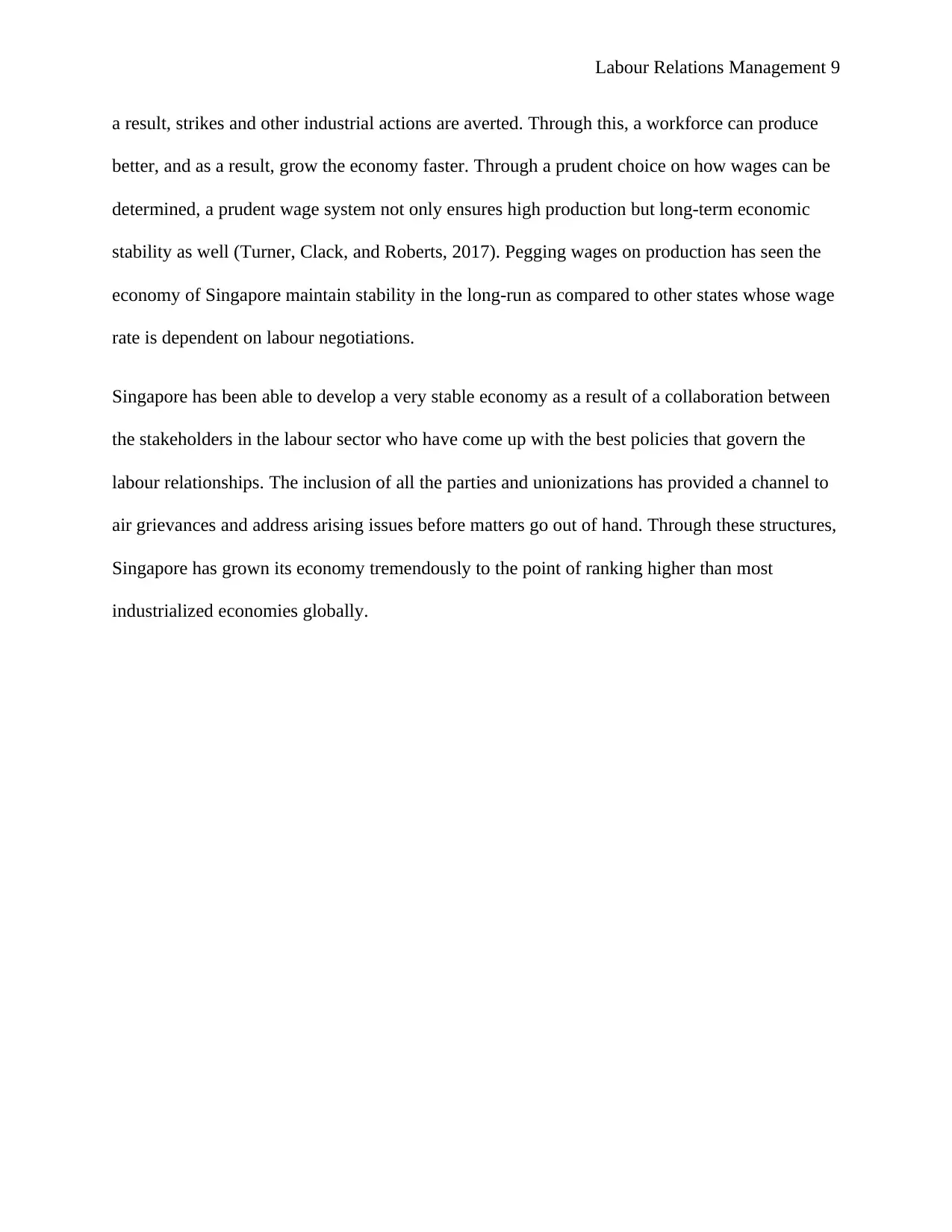
Labour Relations Management 9
a result, strikes and other industrial actions are averted. Through this, a workforce can produce
better, and as a result, grow the economy faster. Through a prudent choice on how wages can be
determined, a prudent wage system not only ensures high production but long-term economic
stability as well (Turner, Clack, and Roberts, 2017). Pegging wages on production has seen the
economy of Singapore maintain stability in the long-run as compared to other states whose wage
rate is dependent on labour negotiations.
Singapore has been able to develop a very stable economy as a result of a collaboration between
the stakeholders in the labour sector who have come up with the best policies that govern the
labour relationships. The inclusion of all the parties and unionizations has provided a channel to
air grievances and address arising issues before matters go out of hand. Through these structures,
Singapore has grown its economy tremendously to the point of ranking higher than most
industrialized economies globally.
a result, strikes and other industrial actions are averted. Through this, a workforce can produce
better, and as a result, grow the economy faster. Through a prudent choice on how wages can be
determined, a prudent wage system not only ensures high production but long-term economic
stability as well (Turner, Clack, and Roberts, 2017). Pegging wages on production has seen the
economy of Singapore maintain stability in the long-run as compared to other states whose wage
rate is dependent on labour negotiations.
Singapore has been able to develop a very stable economy as a result of a collaboration between
the stakeholders in the labour sector who have come up with the best policies that govern the
labour relationships. The inclusion of all the parties and unionizations has provided a channel to
air grievances and address arising issues before matters go out of hand. Through these structures,
Singapore has grown its economy tremendously to the point of ranking higher than most
industrialized economies globally.
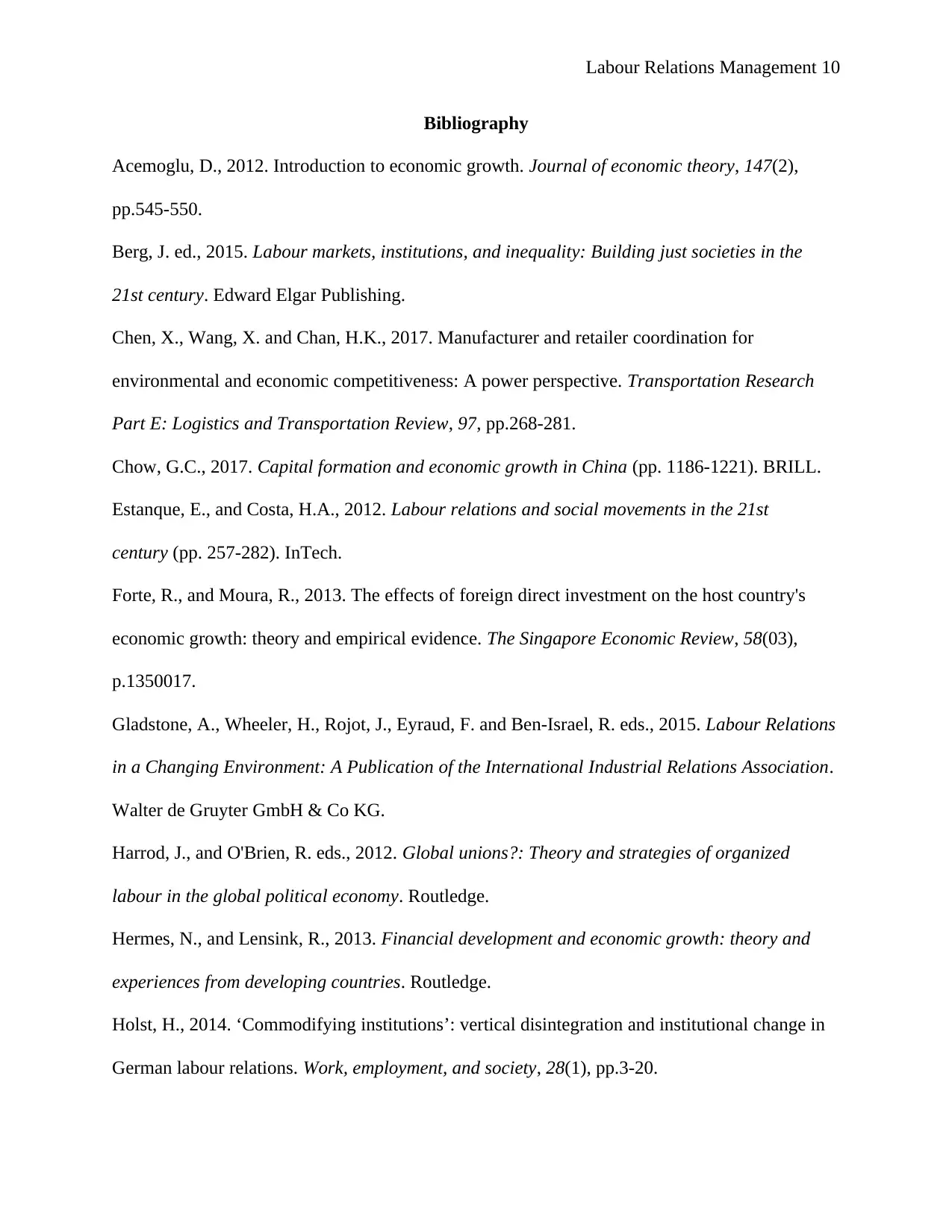
Labour Relations Management 10
Bibliography
Acemoglu, D., 2012. Introduction to economic growth. Journal of economic theory, 147(2),
pp.545-550.
Berg, J. ed., 2015. Labour markets, institutions, and inequality: Building just societies in the
21st century. Edward Elgar Publishing.
Chen, X., Wang, X. and Chan, H.K., 2017. Manufacturer and retailer coordination for
environmental and economic competitiveness: A power perspective. Transportation Research
Part E: Logistics and Transportation Review, 97, pp.268-281.
Chow, G.C., 2017. Capital formation and economic growth in China (pp. 1186-1221). BRILL.
Estanque, E., and Costa, H.A., 2012. Labour relations and social movements in the 21st
century (pp. 257-282). InTech.
Forte, R., and Moura, R., 2013. The effects of foreign direct investment on the host country's
economic growth: theory and empirical evidence. The Singapore Economic Review, 58(03),
p.1350017.
Gladstone, A., Wheeler, H., Rojot, J., Eyraud, F. and Ben-Israel, R. eds., 2015. Labour Relations
in a Changing Environment: A Publication of the International Industrial Relations Association.
Walter de Gruyter GmbH & Co KG.
Harrod, J., and O'Brien, R. eds., 2012. Global unions?: Theory and strategies of organized
labour in the global political economy. Routledge.
Hermes, N., and Lensink, R., 2013. Financial development and economic growth: theory and
experiences from developing countries. Routledge.
Holst, H., 2014. ‘Commodifying institutions’: vertical disintegration and institutional change in
German labour relations. Work, employment, and society, 28(1), pp.3-20.
Bibliography
Acemoglu, D., 2012. Introduction to economic growth. Journal of economic theory, 147(2),
pp.545-550.
Berg, J. ed., 2015. Labour markets, institutions, and inequality: Building just societies in the
21st century. Edward Elgar Publishing.
Chen, X., Wang, X. and Chan, H.K., 2017. Manufacturer and retailer coordination for
environmental and economic competitiveness: A power perspective. Transportation Research
Part E: Logistics and Transportation Review, 97, pp.268-281.
Chow, G.C., 2017. Capital formation and economic growth in China (pp. 1186-1221). BRILL.
Estanque, E., and Costa, H.A., 2012. Labour relations and social movements in the 21st
century (pp. 257-282). InTech.
Forte, R., and Moura, R., 2013. The effects of foreign direct investment on the host country's
economic growth: theory and empirical evidence. The Singapore Economic Review, 58(03),
p.1350017.
Gladstone, A., Wheeler, H., Rojot, J., Eyraud, F. and Ben-Israel, R. eds., 2015. Labour Relations
in a Changing Environment: A Publication of the International Industrial Relations Association.
Walter de Gruyter GmbH & Co KG.
Harrod, J., and O'Brien, R. eds., 2012. Global unions?: Theory and strategies of organized
labour in the global political economy. Routledge.
Hermes, N., and Lensink, R., 2013. Financial development and economic growth: theory and
experiences from developing countries. Routledge.
Holst, H., 2014. ‘Commodifying institutions’: vertical disintegration and institutional change in
German labour relations. Work, employment, and society, 28(1), pp.3-20.
Secure Best Marks with AI Grader
Need help grading? Try our AI Grader for instant feedback on your assignments.
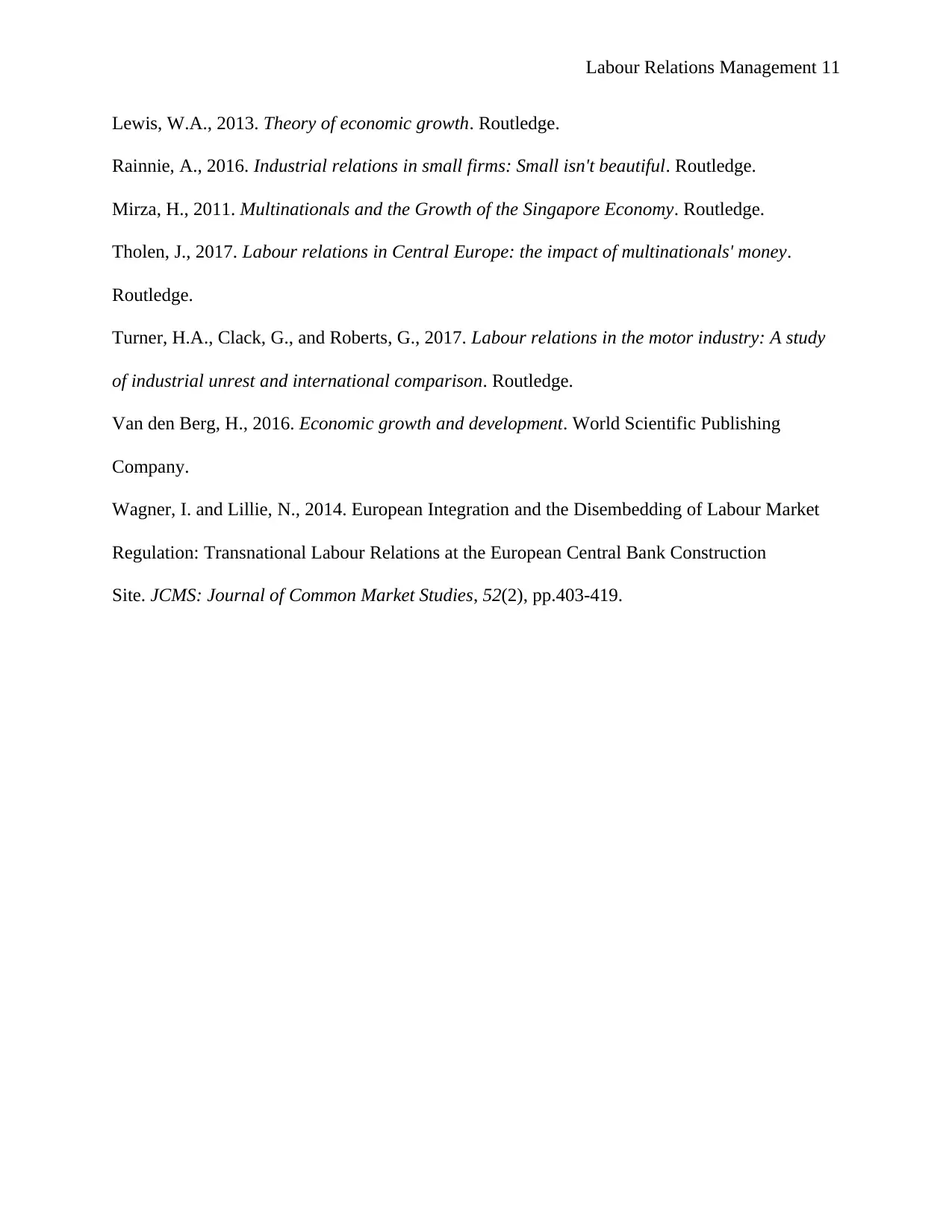
Labour Relations Management 11
Lewis, W.A., 2013. Theory of economic growth. Routledge.
Rainnie, A., 2016. Industrial relations in small firms: Small isn't beautiful. Routledge.
Mirza, H., 2011. Multinationals and the Growth of the Singapore Economy. Routledge.
Tholen, J., 2017. Labour relations in Central Europe: the impact of multinationals' money.
Routledge.
Turner, H.A., Clack, G., and Roberts, G., 2017. Labour relations in the motor industry: A study
of industrial unrest and international comparison. Routledge.
Van den Berg, H., 2016. Economic growth and development. World Scientific Publishing
Company.
Wagner, I. and Lillie, N., 2014. European Integration and the Disembedding of Labour Market
Regulation: Transnational Labour Relations at the European Central Bank Construction
Site. JCMS: Journal of Common Market Studies, 52(2), pp.403-419.
Lewis, W.A., 2013. Theory of economic growth. Routledge.
Rainnie, A., 2016. Industrial relations in small firms: Small isn't beautiful. Routledge.
Mirza, H., 2011. Multinationals and the Growth of the Singapore Economy. Routledge.
Tholen, J., 2017. Labour relations in Central Europe: the impact of multinationals' money.
Routledge.
Turner, H.A., Clack, G., and Roberts, G., 2017. Labour relations in the motor industry: A study
of industrial unrest and international comparison. Routledge.
Van den Berg, H., 2016. Economic growth and development. World Scientific Publishing
Company.
Wagner, I. and Lillie, N., 2014. European Integration and the Disembedding of Labour Market
Regulation: Transnational Labour Relations at the European Central Bank Construction
Site. JCMS: Journal of Common Market Studies, 52(2), pp.403-419.
1 out of 11
Related Documents
Your All-in-One AI-Powered Toolkit for Academic Success.
+13062052269
info@desklib.com
Available 24*7 on WhatsApp / Email
![[object Object]](/_next/static/media/star-bottom.7253800d.svg)
Unlock your academic potential
© 2024 | Zucol Services PVT LTD | All rights reserved.





